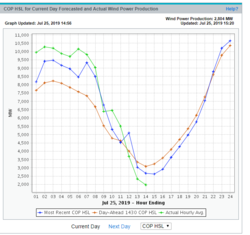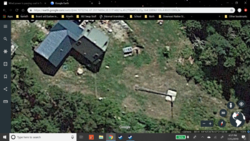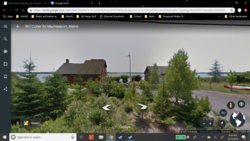Wind power is passing coal in Texas so far this year
- Thread starter begreen
- Start date
-
Active since 1995, Hearth.com is THE place on the internet for free information and advice about wood stoves, pellet stoves and other energy saving equipment.
We strive to provide opinions, articles, discussions and history related to Hearth Products and in a more general sense, energy issues.
We promote the EFFICIENT, RESPONSIBLE, CLEAN and SAFE use of all fuels, whether renewable or fossil.
You are using an out of date browser. It may not display this or other websites correctly.
You should upgrade or use an alternative browser.
You should upgrade or use an alternative browser.
Zack R
Feeling the Heat
It's pretty impressive how many wind projects are online in TX. As a 12+ year veteran in the wind energy industry I've spent a lot of time in TX and it still surprises me every time I drive through the panhandle.
Fortunately wind and solar are very complimentary, when the wind slows down during the day solar can pick up the slack, vice versa at night.

Fortunately wind and solar are very complimentary, when the wind slows down during the day solar can pick up the slack, vice versa at night.

Last edited by a moderator:
SpaceBus
Minister of Fire
It's pretty impressive how many wind projects are online in TX. As a 12+ year veteran in the wind energy industry I've spent a lot of time in TX and it still surprises me every time I drive through the panhandle.
Fortunately wind and solar are very complimentary, when the wind slows down during the day solar can pick up the slack, vice versa at night.
View attachment 245938
What is it that prevents wind from being effective on a residential level? One of my "neighbors" has a huge windmill, at least 60' tall, that is incredibly loud when the wind is 20+ mph. In fact, I can hear it through the forest and it's about 1/4 mile away. Below you can see the Google Earth "3d" image of their tower/house. It's on a ridge, just a little higher in elevation than my house, so it must get great wind exposure. Unfortunately I don't know these folks and haven't been able to ask them any details. There's also another house with a three blade windmill on a 40-ish foot tall mast not too far from me as the crow flies, but I don't know them either. From the noise I hear from my neighbor's 'mill, it doesn't seem like something I'd like regardless, but I like the idea of it.

Last edited:
SpaceBus
Minister of Fire
Zack R
Feeling the Heat
What is it that prevents wind from being effective on a residential level? One of my "neighbors" has a huge windmill, at least 60' tall, that is incredibly loud when the wind is 20+ mph. In fact, I can hear it through the forest and it's about 1/4 mile away. Below you can see the Google Earth "3d" image of their tower/house. It's on a ridge, just a little higher in elevation than my house, so it must get great wind exposure. Unfortunately I don't know these folks and haven't been able to ask them any details. There's also another house with a three blade windmill on a 40-ish foot tall mast not too far from me as the crow flies, but I don't know them either. From the noise I hear from my neighbor's 'mill, it doesn't seem like something I'd like regardless, but I like the idea of it.
View attachment 245941
I'm no expert on small scale wind turbines however in general they lack many of the features of commercial scale units.
Commercial scale
- Significant R&D to maximize output and minimize noise
- Significant effort spent in siting and optimizing the locations
- Hub height of 80+meters allows for a stronger more stable wind resource
- Complex control systems pitch the blades to maximize power output based on wind speed, they also yaw the turbine into the wind
- Staffed control centers are operated 24x7 (just like any other power plant) and can identify issues with each turbine as it comes up
- Scale, the larger swept area allows for significantly more power production at lower wind speed
Residential scale
- Very simple and low cost, some R&D but not in the same league by a large margin
- These units are stall controlled instead of pitch controlled. Stall control poses many issues regarding vibrations, blade shapes, etc...
- Siting is a less exhaustive exercise, limited to your own property which may not be optimal
- Low hub height results in more flow disturbance from trees, buildings, etc... also less wind
- Small rotor diameter results in the need for high winds to produce any power
- No "control system" to speak of
I think of a commercial scale wind turbine as something like a Boeing 747, and a residential scale unit as RC airplane. Other than the fact that they both covert wind into energy they are really so far apart its difficult to compare.
Personally for residential use I would choose solar over small scale wind any day of the week. Solar is benefiting from all of the utility scale advancements and price reductions while at the same time has zero moving parts (unless you want it to with a tracker).
SpaceBus
Minister of Fire
I'm no expert on small scale wind turbines however in general they lack many of the features of commercial scale units.
Commercial scale
- Significant R&D to maximize output and minimize noise
- Significant effort spent in siting and optimizing the locations
- Hub height of 80+meters allows for a stronger more stable wind resource
- Complex control systems pitch the blades to maximize power output based on wind speed, they also yaw the turbine into the wind
- Staffed control centers are operated 24x7 (just like any other power plant) and can identify issues with each turbine as it comes up
- Scale, the larger swept area allows for significantly more power production at lower wind speed
Residential scale
- Very simple and low cost, some R&D but not in the same league by a large margin
- These units are stall controlled instead of pitch controlled. Stall control poses many issues regarding vibrations, blade shapes, etc...
- Siting is a less exhaustive exercise, limited to your own property which may not be optimal
- Low hub height results in more flow disturbance from trees, buildings, etc... also less wind
- Small rotor diameter results in the need for high winds to produce any power
- No "control system" to speak of
I think of a commercial scale wind turbine as something like a Boeing 747, and a residential scale unit as RC airplane. Other than the fact that they both covert wind into energy they are really so far apart its difficult to compare.
Personally for residential use I would choose solar over small scale wind any day of the week. Solar is benefiting from all of the utility scale advancements and price reductions while at the same time has zero moving parts (unless you want it to with a tracker).
Wow, I did not know there was such a difference. I suspect that residential wind turbines are also super expensive. Thanks for the lesson!
peakbagger
Minister of Fire
The wind resource is critical, its it not continuously annoying its not high enough for viable production. If you look at the treetops they should exhibit "flagging" where the leader is bent in the direction of the prevailing wind. Turbulence usually causes noise. and rough terrain causes turbulence. In order to get at the best resource many turbines are located on hilltops and ridgelines and the tradeoff is turbulence. All turbines require routine maintenance and few owners are interested or able to do it. All small wind turbines have to have a wind speed limiting mechanism. Most of these mechanisms reduce the efficiency of power collection by making the turbine less efficient. The excess wind energy is converted to noise. The old Jacobs design has variable pitch angle of the blades with a flyball govenor which is pretty effective but expensive. The easiest way is change the tail angle so the turbine rotates out of wind. Its simple but real noisy. Simple requires less maintenance.
There are some beefy small wind turbine designs but usually someone comes up with a "new design" built with cheap parts and a high markup and continues the small wind reputation for junk. There have been attempts to do third party testing of small wind turbines but few passed and most companies stay away. There is a scottsman who is the guru of small wind. He is highly respected. Do some searching for Hugh Pigott. My old employers design, the Northwind 100, was designed to be the smallest turbine that could be designed to be maintainable and generate power reliably in nasty climates. Its a 100KW design and last thing I knew they were around 500K installed.
There are some beefy small wind turbine designs but usually someone comes up with a "new design" built with cheap parts and a high markup and continues the small wind reputation for junk. There have been attempts to do third party testing of small wind turbines but few passed and most companies stay away. There is a scottsman who is the guru of small wind. He is highly respected. Do some searching for Hugh Pigott. My old employers design, the Northwind 100, was designed to be the smallest turbine that could be designed to be maintainable and generate power reliably in nasty climates. Its a 100KW design and last thing I knew they were around 500K installed.
They are also much higher maintenance. A friend powered his 3,000 sq ft home up in Haines, AK with a what was a decent wind system at the time. It was a royal pita. Besides mechanical failures which always seemed to happen when the weather is miserable, he also cooked a set of expensive deep cycle batteries when a regulator failed. After 2.5 yrs he was so fed up that he got together with the neighbors and created a local utility that financed a local water-powered system.Wow, I did not know there was such a difference. I suspect that residential wind turbines are also super expensive. Thanks for the lesson!
peakbagger
Minister of Fire
The joke is "small' wind turbines rapidly become moving kinetic sculptures and then eventually become stationary ones so the owners had better like the looks of them. Northern Power got its start as bunch of very intelligent ski bums/stoners that needed power and went around salvaging old wind turbines installed in the 1930s and rehabbing them for sale to back to landers. They eventually ran out of units to salvage so they designed their own and got some government bucks to build one for Antarctica https://www.southpolestation.com/trivia/90s/turbine.html
There was a period of time in the 1980s where wind turbines got big incentives and a lot of farmers in VT put in wind turbines. They also went in the Altamont Pass in CA in great numbers. Many were not designed or maintained well and stopped working soon after installation. When I am driving through the Vermont. I see several prominent ones with the blades stripped off an turned into cell towers and a few with nothing on them. I do see a lot of the grid tied Skystreams that were popular 10 years ago, many are still spinning but no idea if they are putting out power. Most were installed in poor wind sites with potential for high turbulence.
The big MW class wind turbines are another story, they are designed to be maintained and have staffs of trained people to monitor them. The future is bigger and bigger units and the biggest ones will end up offshore where the wind is far more reliable. There are several island wind turbines that have gone through hurricanes.
There was a period of time in the 1980s where wind turbines got big incentives and a lot of farmers in VT put in wind turbines. They also went in the Altamont Pass in CA in great numbers. Many were not designed or maintained well and stopped working soon after installation. When I am driving through the Vermont. I see several prominent ones with the blades stripped off an turned into cell towers and a few with nothing on them. I do see a lot of the grid tied Skystreams that were popular 10 years ago, many are still spinning but no idea if they are putting out power. Most were installed in poor wind sites with potential for high turbulence.
The big MW class wind turbines are another story, they are designed to be maintained and have staffs of trained people to monitor them. The future is bigger and bigger units and the biggest ones will end up offshore where the wind is far more reliable. There are several island wind turbines that have gone through hurricanes.
The real issue with small versus big wind is that wind just blows faster and more steadily with altitude, and it just keeps increasing as you go up. In fact, the reductions in the cost of industrial wind have largely been the result of steadily larger/taller machines. This is why many older/smaller machines (like your see from I-95 in New England) are prominent financial boondoggles.
Conversely, if still larger machines were built (like 2X taller than current state of the art) the amount of the power resource becomes large enough to power the US, and many regions that currently don't have a good resource, then suddenly DO. The issue is getting that parts to the work site ... can't fit on existing roads or tracks.
Conversely, if still larger machines were built (like 2X taller than current state of the art) the amount of the power resource becomes large enough to power the US, and many regions that currently don't have a good resource, then suddenly DO. The issue is getting that parts to the work site ... can't fit on existing roads or tracks.
peakbagger
Minister of Fire
Thats why offshore wind turbines are the place for growth. Shipbuilding techniques can be used to build and erect them. Ground based units are at the point where the crane required to erect them are the limiting factor. Despite making the cranes modular they can not make them any larger and still move them over the road.
The net results of the competitiveness of renewables and nat gas are starting to show. Several mega coal plants shutting down this year.
https://www.scientificamerican.com/article/and-now-the-really-big-coal-plants-begin-to-close/
https://www.scientificamerican.com/article/and-now-the-really-big-coal-plants-begin-to-close/
Last edited:
peakbagger
Minister of Fire
Coal plants do not ramp well compared to combined cycle gas plants (days versus minutes). All sorts of cheap natural gas available as a "waste product" from enhanced oil recovery means coal plants just can not compete.
Similar threads
- Replies
- 47
- Views
- 980
- Replies
- 13
- Views
- 589
- Replies
- 37
- Views
- 2K
- Replies
- 97
- Views
- 4K


